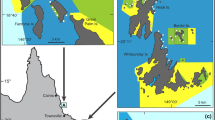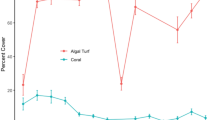Abstract
Coral reefs are of global concern in the face of increasing anthropogenic disturbance. Much research has focused on the negative factors associated with coral reef decline, but few have documented the positive factors in relation to recovering coral reefs. Here, we report a positive quantitative association between sea urchins (diadematids), coral recruitment and coral recovery, recorded along Taiwanese coral reefs. We monitored coral cover change, juvenile coral density, herbivore density (fishes, sea urchins, gastropods) and macroalgal cover, along three reefs between 2012 and 2015. Multivariable regression analyses revealed that sea urchin (diadematids) density was the primary (positive) driver, explaining 74% of variation in coral cover change and 89% in coral juvenile density among sites and years. The relationship between sea urchin density and coral juvenile density was especially evident for four common coral genera: Acropora, Dipsastraea, Pocillopora and Porites. These results suggest that diadematid urchins enhance coral recovery on these reefs by promoting the recruitment of corals. The density of juvenile corals was also found to explain 67% of variation in coral cover change, highlighting the potential use of coral juvenile density as a proxy for coral recovery potential in coral resilience studies.




Similar content being viewed by others
References
Arnold SN, Steneck RS, Mumby PJ (2010) Running the gauntlet: inhibitory effects of algal turfs on the processes of coral recruitment. Mar Ecol Prog Ser 414:91–105
Bellwood DR, Hughes TP, Folke C, Nyström M (2004) Confronting the coral reef crisis. Nature 429:827–833
Benayahu Y, Loya Y (1977) Seasonal occurrence of benthic-algae communities and grazing regulation by sea urchins at the coral reefs of Eilat. In: Proceedings of 3rd international coral reef symposium, vol 1, pp 383–389
Birrell CL, McCook LJ, Willis BL (2005) Effects of algal turfs and sediment on coral settlement. Mar Pollut Bull 51:408–414
Brandl SJ, Rasher DB, Côté IM, Casey JM, Darling ES, Lefcheck JS, Duffy JE (2019) Coral reef ecosystem functioning: eight core processes and the role of biodiversity. Front Ecol Environ 17:445–454
Bronstein O, Loya Y (2014) Echinoid community structure and rates of herbivory and bioerosion on exposed and sheltered reefs. J Exp Mar Biol Ecol 456:8–17
Bruno JF, Selig ER (2007) Regional decline of coral cover in the Indo-Pacific: timing, extent, and subregional comparisons. PLoS ONE 2:e711
Carpenter RC (1986) Partitioning herbivory and its effects on coral reef algal communities. Ecol Monogr 56:345–364
Carpenter RC, Edmunds PJ (2006) Local and regional scale recovery of Diadema promotes recruitment of scleractinian corals. Ecol Lett 9:271–280
De’ath G, Fabricius KE, Sweatman H, Puotinen M (2012) The 27-yr decline of coral cover on the Great Barrier Reef and its causes. PNAS 109:17995–17999
Diaz-Pulido G, McCook LJ, Dove S, Berkelmans R, Roff G, Kline DI, Weeks S, Evans RD, Williamson DH, Hoegh-Guldberg O (2009) Doom and boom on a resilient reef: climate change, algal overgrowth and coral recovery. PloS One 4:e5239
Dumont CP, Lau DC, Astudillo JC, Fong KF, Chak ST, Qiu JW (2013) Coral bioerosion by the sea urchin Diadema setosum in Hong Kong: susceptibility of different coral species. J Exp Mar Biol Ecol 441:71–79
Edmunds PJ (2000) Patterns in the distribution of juvenile corals and coral reef community structure in St. John, US Virgin Islands. Mar Ecol Prog Ser 202:113–124
Edmunds PJ, Carpenter RC (2001) Recovery of Diadema antillarum reduces macroalgal cover and increases abundance of juvenile corals on a Caribbean reef. PNAS 98:5067–5071
Eynaud Y, McNamara DE, Sandin SA (2016) Herbivore space use influences coral reef recovery. R Soc Open Sci 3:160262
Gardner TA, Côté IM, Gill JA, Grant A, Watkinson AR (2003) Long-term region-wide declines in Caribbean corals. Science 301:958–960
Gilmour JP, Smith LD, Heyward AJ, Baird AH, Pratchett MS (2013) Recovery of an isolated coral reef system following severe disturbance. Science 340:69–71
Graham NA, Jennings S, MacNeil MA, Mouillot D, Wilson SK (2015) Predicting climate-driven regime shifts versus rebound potential in coral reefs. Nature 518:94–97
Green AL, Bellwood DR, Choat H (2009) Monitoring functional groups of herbivorous reef fishes as indicators of coral reef resilience. A practical guide for coral reef managers in the Asia Pacific Region. IUCN, Gland, Switzerland
Hoey AS, Pratchett MS, Cvitanovic C (2011) High macroalgal cover and low coral recruitment undermines the potential resilience of the world’s southernmost coral reef assemblages. PLoS One 6(10):e25824
Hughes TP (1994) Catastrophes, phase shifts, and large-scale degradation of a Caribbean coral reef. Science 265:1547–1551
Hughes TP, Rodrigues MJ, Bellwood DR, Ceccarelli D, Hoegh-Guldberg O, McCook L, Moltschaniwskyj N, Pratchett MS, Steneck RS, Willis B (2007) Phase shifts, herbivory, and the resilience of coral reefs to climate change. Curr Biol 17:360–365
Hughes TP, Graham NA, Jackson JB, Mumby PJ, Steneck RS (2010) Rising to the challenge of sustaining coral reef resilience. Trends Ecol Evol 25:633–642
Hughes TP, Anderson KD, Connolly SR, Heron SF, Kerry JT, Lough JM, Baird AH, Baum JK, Berumen ML, Bridge TC, Claar DC, Eakin CM, Gilmour JP, Graham NAJ, Harrison H, Hobbs J-PA, Hoey AS, Hoogenboom M, Lowe RJ, McCulloch MT, Pandolfi JM, Pratchett M, Schoepf V, Torda G, Wilson SK (2018) Spatial and temporal patterns of mass bleaching of corals in the Anthropocene. Science 359:80–83
Hughes TP, Kerry JT, Baird AH, Connolly SR, Chase TJ, Dietzel A, Hill T, Hoey AS, Hoogenboom MO, Jacobson M, Kerswell A, Madin JS, Mieog A, Paley AS, Pratchett MS, Torda G, Woods RM (2019) Global warming impairs stock–recruitment dynamics of corals. Nature 568:387–390
Humphries AT, McClanahan TR, McQuaid CD (2014) Differential impacts of coral reef herbivores on algal succession in Kenya. Mar Ecol Prog Ser 504:119–132
Idjadi JA, Haring RN, Precht WF (2010) Recovery of the sea urchin Diadema antillarum promotes scleractinian coral growth and survivorship on shallow Jamaican reefs. Mar Ecol Prog Ser 403:91–100
Jackson JB, Kirby MX, Berger WH, Bjorndal KA, Botsford LW, Bourque BJ, Bradbury RH, Cooke R, Erlandson J, Estes JA (2001) Historical overfishing and the recent collapse of coastal ecosystems. Science 293:629–637
Mumby P, Steneck R (2008) Coral reef management and conservation in light of rapidly evolving ecological paradigms. Trends Ecol Evol 23:555–563
Mumby PJ, Harborne AR, Williams J, Kappel CV, Brumbaugh DR, Micheli F, Holmes KE, Dahlgren CP, Paris CB, Blackwell PG (2007) Trophic cascade facilitates coral recruitment in a marine reserve. PNAS 104:8362–8367
Mumby PJ, Steneck RS, Adjeroud M, Arnold SN (2016) High resilience masks underlying sensitivity to algal phase shifts of Pacific coral reefs. Oikos 125:644–655
Nakagawa S, Johnson PCD, Schielzeth H (2017) The coefficient of determination R2 and intra-class correlation coefficient from generalized linear mixed-effects models revisited and expanded. J R Soc Interface 14:20170213
Omori M, Kubo H, Kajiwara K, Matsumoto H, Watanuki A (2006) Rapid recruitment of corals on top shell snail aquaculture structures. Coral Reefs 25:280
Qiu JW, Lau DC, Cheang CC, Chow WK (2014) Community-level destruction of hard corals by the sea urchin Diadema setosum. Mar Pollut Bull 85:783–788
R Core Team (2019) R: a language and environment for statistical computing. R Foundation for Statistical Computing, Vienna
Roff G, Mumby PJ (2012) Global disparity in the resilience of coral reefs. Trends Ecol Evol 27:404–413
Ruengsawang N, Yeemin T (2000) Bioerosion caused by grazing activities on coral communities in the Gulf of Thailand. In: Proceedings of 9th international coral reef symposium, vol 1, pp 289–294
Sandin SA, McNamara DE (2012) Spatial dynamics of benthic competition on coral reefs. Oecologia 168:1079–1090
Villanueva RD, Baria MVB, dela Cruz DW (2013) Effects of grazing by herbivorous gastropod (Trochus niloticus) on the survivorship of cultured coral spat. Zool Stud 52:44
Wilkinson C (2008) Status of the coral reefs of the world: 2008. Global Coral Reef Monitoring Network and Reef and Rainforest Research Centre, Townsville
Wittenberg M, Hunte W (1992) Effects of eutrophication and sedimentation on juvenile corals. Mar Biol 112:131–138
Acknowledgements
We thank students and assistants for data collection. Y.N. especially thanks H.-S. Hsieh, C.-H. Liu and S.-Y. Liu for data measurement and A. Mulla for English editing. Comments from the editor and reviewers improved the manuscript. The study was funded by an internal research Grant of Biodiversity Research Center, Academia Sinica, to Y.N.
Author information
Authors and Affiliations
Corresponding author
Ethics declarations
Conflict of interest
On behalf of all authors, the corresponding author states that there is no conflict of interest.
Additional information
Topic Editor Andrew Hoey
Publisher's Note
Springer Nature remains neutral with regard to jurisdictional claims in published maps and institutional affiliations.
Electronic supplementary material
Below is the link to the electronic supplementary material.
Rights and permissions
About this article
Cite this article
Nozawa, Y., Lin, CH. & Meng, PJ. Sea urchins (diadematids) promote coral recovery via recruitment on Taiwanese reefs. Coral Reefs 39, 1199–1207 (2020). https://doi.org/10.1007/s00338-020-01955-1
Received:
Accepted:
Published:
Issue Date:
DOI: https://doi.org/10.1007/s00338-020-01955-1




